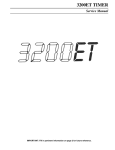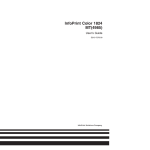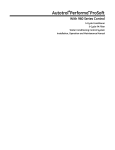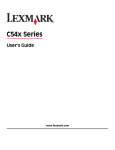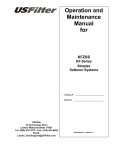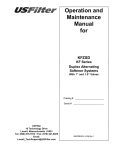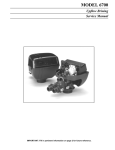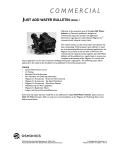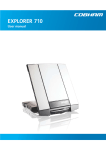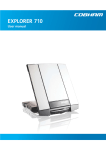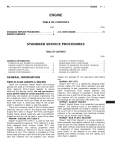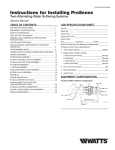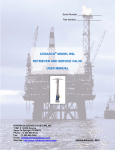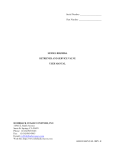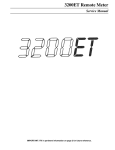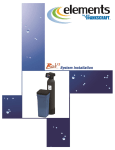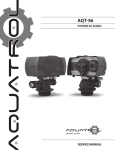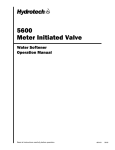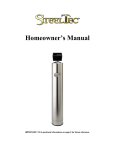Download USF KF Twin-Tank Softener (1
Transcript
Operation and Maintenance Manual for Model KF Twin-Tank Softener System with Single 1” or 1½” Valve U.S. Filter Project # _ _ _ _ _ USF Document P/N 133100180 November 23, 1998 At higher salt dosages, the softener will treat more water between regenerations, create less overall waste, and produce lower-hardness effluent. At lower salt dosages, the softener will use less overall salt. For dosages below 9 #/ft3, consult U.S. Filter Customer Service. U.S. Filter P.O. Box 560 ∃ 4669 Shepherd Trail Rockford, Illinois 61105 Tel: 815-877-3041 ∃ Fax: 815-877-0172 U.S. FILTER COMMERCIAL PRODUCT LINE KF TWIN-TANK SOFTENER WITH SINGLE 1” OR 1½” VALVE Page 1 TWIN-MANa 12/6/02 DRH Congratulations on your purchase of one of the finest water treatment products available! Through proper installation, operation, and maintenance, this system will provide you with many years of satisfactory service. U.S. Filter values your business and is committed to your satisfaction in our products. Thank you for purchasing this product—we believe your investment will be a good one. TABLE OF CONTENTS Section 1.0 ......Introduction .................Page 2 Section 2.0 ......Installation....................Page 3 Section 3.0 ......Startup & Operation ...Page 11 Section 4.0 ......Shutdown.....................Page 26 Section 5.0 ......Sampling & Testing......Page 26 Section 6.0 ......Maintenance...............Page 28 Section 7.0 ......Parts List ........................Page 32 Section 8.0 ......Appendix .....................Page 44 GENERAL SAFETY INFORMATION CODES Be sure to comply with all applicable local, state, and federal codes. to come in contact with liquids. Be sure to unplug the controller before servicing any electrical components. EQUIPMENT INSPECTION Thoroughly inspect the equipment upon receipt and account for all items on the packing slip. Claims for items lost or damaged in shipment must be filed with the delivery carrier immediately TEMPERATURES The maximum operating temperature is 100oF. TRAINING All operators must be properly trained and familiar with the operation of the equipment. UNSECURED VESSELS Empty vessels must be securely braced until they are permanently mounted. Small vessels which are not loaded with media may be unbalanced when stood upright ELECTRICAL COMPONENTS All electrical components must be properly wired and grounded, and must not be allowed U.S. FILTER AUTOMATIC COMPONENTS Before working on automatically controlled components, disable the controller so that it will not operate the components. Sudden and unexpected operation of components being serviced can cause severe injury. PRESSURES Verify that all pressures are relieved before working on this system and its components. Inlet pressure must be 30-110 psi. MATERIAL SAFETY DATA SHEETS These data sheets contain important safety and first-aid information for supplied Materials. The MSDS sheets are included in the Appendix section of this manual (section 8). Taking care of the world’s water…and yours. U.S. FILTER COMMERCIAL PRODUCT LINE KF TWIN-TANK SOFTENER WITH SINGLE 1” OR 1½” VALVE Page 2 TWIN-MANa 12/6/02 DRH SECTION 1.0 INTRODUCTION 1.1 If problems or questions should arise during system operation, refer to the troubleshooting table in section 3.4 for assistance. If the problem is not resolved, contact your representative; be sure to have the Title Page Specification Sheet in hand when you call. ABOUT THIS MANUAL This manual has been written with both you and your U.S. Filter area representative in mind. Most of the information contained in this manual will help you to install, start up, and operate your water treatment system. Therefore, you should read this manual before commissioning this system. In addition, details have been added to the manual to assist your representative in filling out the Specification Sheet on page 2. 1.2 SYSTEM SPECIFICATIONS The Specification Sheet for your system in included on the next page. Table 1: Equipment and Process Specifications Tank Size (“D x “H) Pipe Size (in.) 7 x 44 9 x 40 10 x 54 12 x 52 12 x 52 14 x 65 14 x 65 16 x 65 16 x 65 18 x 65 21 x 62 21 x 62 24 x 72 24 x 72 24 x 72 1.0 1.0 1.0 1.0 1.5 1.0 1.5 1.0 1.5 1.5 1.5 1.5 1.5 1.5 1.5 6 Resin 1/8”x Motor 2Capacity Vol. 1/16” Speed @ 15#/ft3 (ft3) Gravel (rpm) dosage in Tnk (Kgr) (lbs) 0.5 none 1/15 15 1.0 none 1/15 30 1.5 none 1/15 45 2.0 none 1/15 60 2.0 none 1/15 60 3.0 40 1/30 90 3.0 40 1/30 90 4.0 55 1/30 120 4.0 55 1/30 120 5.0 100 1/30 150 6.0 100 1/30 180 7.0 100 1/30 210 8.0 175 1/30 240 9.0 175 1/30 270 10.0 175 1/30 300 Max. Service Flow (gpm) R.O. Pretreat --2.6 --4.7 4.7 6.4 6.4 8.4 8.4 10.6 12.7 14.4 16.8 18.8 21.2 Stand Alone 15.0 18.0 18.0 19.0 39.0 22.0 42.0 23.0 46.0 48.0 55.0 55.0 57.0 56.0 56.0 Backwash/ Inj. Fill Rapid Rinse Size/ Flow Flow DLFC Color BLFC (gpm) (gpm) 1.2 2.0 2.4 3.5 3.5 5.0 5.0 7.0 7.0 9.0 12.0 12.0 15.0 15.0 15.0 0/R 1/W 1/W 2/B 2/B 3/Y 3/Y 3/Y 3/Y 3C/Y 4C/G 4C/G 5C/W 5C/W 5C/W 0.5 0.5 0.5 0.5 1.0 1.0 1.0 1.0 1.0 2.0 2.0 2.0 2.0 2.0 2.0 3 Cycle Times @ 15#/ft3 dosage 4 (minutes) Brine Backwash 10 10 10 10 10 10 10 10 10 10 10 10 10 10 10 4,5 Brine In 20 21 31 32 32 26 26 34 34 26 14 16 20 24 26 5 Slow Rinse 22 29 48 31 31 46 46 58 58 64 48 48 54 54 54 Rapid Rinse 10 10 10 10 10 10 10 10 10 10 10 10 10 10 10 Tank Fill 9 12 17.5 24 12 16 16 22 22 16 18 18 24 26 26 Brine Tank (“D x “H) Max. Salt in Tk (lbs.) 18 x 40 350 18 x 40 350 18 x 40 350 18 x 40 350 18 x 40 350 18 x 40 350 24 x 50 700 24 x 50 700 24 x 50 700 24 x 50 700 24 x 50 700 24 x 50 700 24 x 50 700 24 x 50 7007 30 x 48 1000 1 For other salt dosages, use the formula: Kgr capacity = #(30 - #) + 16 x ft3 resin, where # = salt dosage in lbs/ft3 8 2 The Brine In and Slow Rinse times are set on each valve timer as a single cycle time, which is the two cycle times added together. 3 For other salt dosages, adjust the Brine In and Brine Tank Fill times using this formula: Cycle time = Time shown x Salt Dosage ÷ 15. 4 For an inlet pressure other than 35 psig, adjust the Brine In and Slow Rinse times using the graphs in Section 8.4 and this formula: Cycle time = Time shown x Flow at 35 psig ÷ Flow at actual psig. 5 For tank sizes that are listed with more than one possible resin amount, refer to the last letter of the model # (see above) to determine whether to use the minimum (Y), median (X), or maximum (Z) resin volume. 6 At higher salt dosages, use 440 lbs of salt instead; if more salt is loaded, the tank may overflow during the Brine Refill step. U.S. FILTER Taking care of the world’s water…and yours. U.S. FILTER COMMERCIAL PRODUCT LINE KF TWIN-TANK SOFTENER WITH SINGLE 1” OR 1½” VALVE Page 3 TWIN-MANa 12/6/02 DRH SECTION 2.0 INSTALLATION 2.1 EQUIPMENT INCLUDED Figure 3: 1-1/2” Softener Components Your U.S. Filter system has been shipped to you in the following assemblies. Check to make sure that none of these appear damaged or missing. For more component details, refer to the drawings and parts lists in section 7. NOTE: For skid-mounted systems (“P” Assembly in the model # on cover), refer instead to the addendum in section 8.8. The vessel assembly consists of (see Figure 1): (2) vessels w/ bottom distributors installed* (1) drain line flow control (DLFC)/injector kit (1) DLFC housing (1½” valve only) (1) control valve w/ cover (1) tank-to-valve bushing (1” valves only)* (1) tubing fitting for brine inlet line (1) upper dispersers (installed on 1” valve and adapter) The brine tank assembly installed consists of (see Figure 4): (1) brine tank with cover (1) well with cap (1) salt grid (1) overflow fitting (1) air check/safety valve (18” brine tank)* (1) air check assy (24” brine tank) (1) 3/8” tube elbow, fittings (7-16” dia)* (1) ½” bushing, elbow, fitting (18-24” dia) (1) length 18’ tubing w/ tee (14-30” dia)* (1) grommet for brine line hole in tank* Figure 1: Components Common to All Softeners Figure 4: Brine Tank Components Softeners with 1” piping also have (see Figure 2): (1) tank adapter (1) tank-to-adapter bushing (1) interconnecting piping assembly (1) lot of couplings & clips (1) lot of fasteners Figure 2: Components for 1” Softener Softeners with 1-1/2” piping also have (See Figure 3): (1) tank adapter (2) (1) interconnecting piping assembly (1) water meter (installed on 1” valve)* (1) length of copper tubing w/ clips for inlet* (1) lot of gravel (if applicable) & cation resin (see page 2)* (2) Operating Manuals* (1) Hardness Test Kit (1) 9VDC battery (units with 3200ET only) U.S. FILTER 2.2 GENERAL INSTALLATION GUIDELINES CODES: Be sure to comply with all applicable local, state, and federal codes. Taking care of the world’s water…and yours. U.S. FILTER COMMERCIAL PRODUCT LINE KF TWIN-TANK SOFTENER WITH SINGLE 1” OR 1½” VALVE Page 4 TWIN-MANa 12/6/02 DRH Figure 5: Media Types for Softeners WATER PRESSURE: The regeneration valve needs 30-110 psi pressure to operate effectively. For pressures outside this range, install a booster pump or regulator in the feed line. Riser tube distributor assembly TEMPERATURES: The operating temperature is 32100oF. For temperatures outside this range, special valve assemblies and conversion kits are available. ELECTRICAL FACILITIES: For most systems, an electrical supply of alternating current (A/C) is required - refer to the Specification Sheet in section 1.2. Make sure the supply is always on and cannot be turned off with another switch. Cation Resin 1/8” x 1/16” (#4) Gravel (if applicable) EXISTING PLUMBING: Condition of existing plumbing should be free from lime and iron buildup. If piping is clogged with iron, a separate iron filter unit should be installed ahead of the water softener. 3. Fill the tank about ¼ full with water. Center the riser tube distributor assembly in the top opening of the softener tank. Pour the proper quantity of 1/8” x 1/16” (#4) gravel (see Table 1 on page 2) into the softener tank - make or buy a large funnel to prevent the gravel from spilling. LOCATION OF SOFTENER AND DRAIN: The softener should be located close to a drain. MANUAL VALVES: Always install manual inlet, outlet, and by-pass valves on systems without skids (“X” Assembly in the model # - see cover). NOTE: Gravel is not used in vessels with 7”, 9”, 10”, and 12” diameters. CAUTION Water pressure is not to exceed 110 p.s.i., water temperature is not to exceed 100°F, and the unit cannot be subjected to freezing conditions. 2.3 4. Level the gravel as best as possible, making sure that all of the strainer slots are covered. 5. Using the same funnel, pour the quantity of resin (see Table 1 on page 2) into the softener tank. Fill the tank with water and soak the resin for at least 2 hours. GRAVEL AND RESIN LOADING NOTE: For skid-mounted softeners, refer instead to the addendum in section 8.8. 1. Place the softener tanks on a firm foundation as close to the floor drain as possible, and level the vessels. 2. A riser tube distributor assembly has been shipped in each softener vessel see Figure 5. Inspect the slotted basket (bottom distributor) to be sure it is not damaged. Also make sure that the top of the riser pipe is flush with the top of the tank flange when the basket is in the middle of the tank and flat on the bottom. Cover the top of the riser tube with tape or a plastic cap to prevent gravel and resin from getting inside the riser pipe. U.S. FILTER CAUTION Before installing the valve, remove the tape or cap from the top of the riser tube. 2.4 VALVE AND PIPING INSTALLATION NOTE: For skid-mounted softeners, refer instead to the addendum in section 8.8. Refer to Table 1 on page 2 for injector and Drain Line Flow Control (DLFC) sizes. 1. (Units with 1’ piping and 7-12” diameter vessels) The control valve has been configured for use with a 9” or 10” diameter tank. If a smaller or larger tank Taking care of the world’s water…and yours. U.S. FILTER COMMERCIAL PRODUCT LINE KF TWIN-TANK SOFTENER WITH SINGLE 1” OR 1½” VALVE Page 5 TWIN-MANa 12/6/02 DRH is used instead, reconfigure the control valve using the following procedures. A. On the Injector Assembly [see Figure 6), remove the two mounting bolts and lift off the cover and gasket. these are included in the supplied kit (see Figure 1). Screw them into the injector body until snug, but do not overtighten. E. Reinstall the injector gasket, cover, and bolts. Figure 6: Injector Location on 1” Valve 2. (Units with 1½” piping and 12-16” diameter tanks) The control valve has been configured for use with a 14” or 16” diameter tank. If a 12” diameter tank is used instead, reconfigure the control valve using the following procedures. A. On the #1600 Injector Assembly [see Figure 8], remove the two mounting bolts and lift off the cover and gasket. Figure 8: 1600 Injector Location on 1-1/2” Valve B. Using a standard screwdriver, unscrew the installed white #1 injector nozzle [see Figure 7] from the injector body. Figure 7: Injector Components for 1” Valve B. Using a standard screwdriver, unscrew the installed yellow #3 injector nozzle and throat [see Figure 9] from the injector body. C. Using a standard screwdriver, unscrew the installed white #1 injector throat from the injector body. D. Install instead the required red or blue injector nozzle and throat, – U.S. FILTER Taking care of the world’s water…and yours. U.S. FILTER COMMERCIAL PRODUCT LINE KF TWIN-TANK SOFTENER WITH SINGLE 1” OR 1½” VALVE Page 6 TWIN-MANa 12/6/02 DRH Figure 10: 1700 Injector Components Figure 9: 1600 Injector Components Cover Gasket Injector Nozzle Screen Cover Nozzle Gasket Throat Injector Body Screen Nozzle Injector Body C. Install instead the required blue #2 injector nozzle and throat, which are included in the supplied kit (see Figure 1)- be sure to seat them tightly. D. Reinstall the injector cover gasket, injector cover, and bolts. 3. (Units with 18-24” diameter tanks) The control valve has been configured for use with a 21” diameter tank. If a 18” or 24” diameter tank is used instead, reconfigure the valve using the following procedures. A. On the #1700 Injector Assembly [see Figure 8], remove the two mounting bolts and pull off the injector cover and its gasket. Throat C. Install instead the required injector nozzle and throat - these are included in the supplied sizing kit (see Figure 1). Screw them into the injector body until snug, but do not overtighten. D. Reinstall the injector gasket, injector cover, and bolts. 4. Note the required Backwash/Rapid Rinse DLFC flow in Table 1, page 2, and install the proper DLFC flow washer [see Figure 11 or 12] into the DLFC housing. Figure 11 DLC Washer Installation for 1” Valve B. Using a standard screwdriver, unscrew the installed green #4C injector nozzle and throat [see Figure 10] from the injector body. Figure 12: DLFC Washer Installation for 1-1/2” Valve U.S. FILTER Taking care of the world’s water…and yours. U.S. FILTER COMMERCIAL PRODUCT LINE KF TWIN-TANK SOFTENER WITH SINGLE 1” OR 1½” VALVE Page 7 TWIN-MANa 12/6/02 DRH Install with numbers on this side On 1” valves, this housing is the uppermost part of the valve - unscrew the retainer piece that is threaded into the housing, place the washer in the housing, and screw the retainer on top of the washer to hold it in place. On 1½” valves, the DLFC housing is shipped loose with the control valve (see Figure 1). The washers are included in the supplied kit (Figure 1, item TBD), each marked with its flow rate. Make sure the number on the washer is facing in the opposite direction of the arrow that is on the housing. 5. (1½“ valves only) Using Figure 15, thread the DLFC housing onto the valve’s drain connection. This is the smaller connection on the left side of the valve, as observed from the front (where the timer is mounted). Make sure that the arrow on the housing is pointing away from the valve. NOTE: Teflon tape is the only sealant to be used on any threaded fittings. 6. Use a silicone base grease to lubricate the two (2) O-rings at the base of the control valve. Also lubricate the two (2) O-rings at the base of the tank #2 adapter. opening in the top of each tank. On 1” valves, first install the supplied tank-tovalve bushing. Make sure that the riser pipe goes into the center opening in the base of the valve or adapter. Hand tighten only - do not use a wrench or any device to apply additional torque or leverage. NOTE: Teflon tape is the only sealant to be used on any threaded fittings. 9. Connect the control valve (on tank #1) to the adapter (on tank #2). For 1” valves, lubricate the four (4) o-ring couplings (Figure 1), insert them into both ends of the interconnecting piping yoke, and use the four (4) clips to attach the yoke to the valve and adapter. For 1½” valves, lubricate the four (4) o-rings on the ends of the interconnecting piping yoke, plug the yoke into the valve and adapter, and secure with the eight (8) fasteners. NOTE: The two tanks must be positioned to relieve any strain on the yokes or piping. 10. Locate the brine tank near the mineral tanks. The brine tank location should be such that it will not interfere with access to the mineral tank control valve or filling the brine tank with salt. The tank must be placed on a smooth firm foundation and leveled. 11. Install the piping using the following procedures and Figures 13 and 14. For greater detail, refer to the applicable installation drawing in section 8.6. Comply with all local, state, and federal plumbing codes. 7. (Units with 1-1/2” valves only) Install the supplied upper disperser to the bottom of each valve by pushing the large end of the disperser into the groove on the bottom of the valve until the disperser locks in place. 8. Carefully thread the control valve and the adapter clockwise into the center U.S. FILTER Taking care of the world’s water…and yours. U.S. FILTER COMMERCIAL PRODUCT LINE KF TWIN-TANK SOFTENER WITH SINGLE 1” OR 1½” VALVE Page 8 TWIN-MANa 12/6/02 DRH Figure 13: Inlet/Outlet Connectors – 1” Valve could cause interior damage to the drain line flow control (DLFC) washer. C. Connect the open port of the DLFC housing (the larger connection on the side of the valve) to an open floor drain (see Figure 11 or 12). Figure 14: Inlet/Outlet Connectors – 1-1/2” Valves A. Install the water meter using the applicable installation drawing and the meter drawing in section 7.3. On units with ¾” meters, clip one side of the meter to the valve’s inlet and outlet connections and the other side to the supplied 1” FNPT threaded pipe yoke, making sure that the arrows on the meter point toward the valve inlet. On units with 1” meters, clip the side of the meter with the o-rings and couplings to the valve’s inlet and outlet connections. On units with 1½” meters, thread the male end of the meter into the valve’s outlet. There must be a 4” air gap between the drain pipe and the floor drain. Teflon tape is the only sealant to be used on the drain fitting. Do not reduce the pipe or tube size of the drain port connection. Make as short a run of drain piping as possible. If it is necessary to run the drain line overhead, consult the factory for proper recommendations. D. Loosely thread the supplied tubing fitting for the brine inlet line (Figure 1) onto the valve’s brine inlet connection. On 1” valves, the brine inlet is on the brine line flow control (BLFC) (see Figure 13). On 1½” valves, the brine inlet is on the brine valve assembly (see Figure 14). E. Run the brine tubing between the air check valve on the brine tank to the control valve’s brine inlet connection (see Figure 13). Cut any excess tubing. Figure 13. Brine Tubing Conection NOTE: Make sure the meter is installed with its dome on top (face up). B. Connect the inlet and outlet piping to the valve and/or meter (see Figure 11 or 12); include unions for easy servicing. NOTE: Teflon tape is the only sealant to be used on any threaded fittings. CAUTION Solder joints at the drain must be done prior to connecting the drain line to the valve. Failure to do this U.S. FILTER NOTE: The dotted portions on the drawings indicate piping and components by Taking care of the world’s water…and yours. U.S. FILTER COMMERCIAL PRODUCT LINE KF TWIN-TANK SOFTENER WITH SINGLE 1” OR 1½” VALVE Page 9 TWIN-MANa 12/6/02 DRH display shows the desired number of days or OFF (to disable the option). others. The shaded portions are also supplied by others except on models with “P” Assemblies (see page 2). F. U.S. Filter recommends that drain tubing be installed connecting the overflow elbow on the side of the brine tank to an open floor drain. Do not run this line overhead; it must be to a gravity drain. Do not make a direct connection to the floor drain. 12. Place approximately 12" of water in the brine tank. Do not add salt at this time. 13. Open the bypass valve, close the inlet and outlet valves, and slowly turn on the main water supply. Open a cold soft water tap nearby and let it run a few minutes or until the system is free from foreign material that may have resulted from the installation. Once clean, close the water tap and bypass valve, and open the inlet valve (leave outlet shut). 14. Plug the loose end of the meter cable into the meter cap assembly (the other end is attached to the control drive). 15. Plug the control unit into an outlet that can deliver the proper type of electrical power (see section 1.2). 16. Program Level #2 on the 3200ET timer using the following procedure. Where needed, refer to the 3200ET Timer Service Manual (supplied separately). A. Push and hold the PROGRAM button until the display changes (approx. 5 seconds). The above the Program Display Indicator will turn on. B. Push and hold the EXTRA CYCLE button until the display changes again (approx. 5 seconds). C. Push and release the PROGRAM button until an “A” appears on the left side of the display. This is the Regeneration Day Override option, which sets the timer to regenerate after the preset number of days even if the volume setpoint has not been exceeded. Use the and buttons until the right side of the U.S. FILTER D. Push and release the PROGRAM button once to go to the Volume Override option, which sets the timer to regenerate when the entered number of gallons has been exceeded (the timer will NOT calculate the volume using the water hardness and resin capacity). Use the and buttons until the right side of the display shows the desired number of gallons or OFF (to disable the option). E. Push and release the PROGRAM button until an “o” appears on the left side of the display. This is the Valve Type setting, which tells the timer which type of valve it is controlling. Use the and buttons until the right side of the display shows “4” (for valves 9000 and 9500). F. Push and release the PROGRAM button once to go to the Regeneration Type setting, which tells the timer how a regeneration should be initiated. Use the and buttons until the right side of the display a “2” (for Meter Immediate Regeneration). With this regen type, the Service softener regenerates immediately when its volume setpoint is reached, and the Standby softener goes into Service. G. Push and release the PROGRAM button once to go to the Flow Meter Size setting, which tells the timer what size meter is being used. Use the and buttons until the right side of the display shows a “1” (for 7-12” diameter units with 1” piping), a “2” (for 14-16” diameter units with 1” piping), or a “3” (for units with 1½” piping). To find the vessel and pipe sizes for your system, refer to the Specification Sheet on page 2. H. Push and release the PROGRAM button until a “9” appears on the left side of the display. This is the System Type setting, which tells the timer Taking care of the world’s water…and yours. U.S. FILTER COMMERCIAL PRODUCT LINE KF TWIN-TANK SOFTENER WITH SINGLE 1” OR 1½” VALVE Page 10 TWIN-MANa 12/6/02 DRH your system, in grains. To find the capacity for your system, refer to Table 1 on page 2. which type of system the controller has been wired for. Use the and buttons until the right side of the display shows a “4” . I. Push and release the PROGRAM button once to go to Program Protection, which can be used to disable changes to the 3200ET program. Use the and buttons until the right side of the display shows “OFF” (to cancel protection) or “ON” (to turn on protection). NOTE: Do NOT select to put Program Protection ON unless absolutely certain none of the programmed settings will ever need changing. The only way to access the settings again is to hold the PROGRAM button in for 25 seconds, which will then return all of your settings to the default values - you will then have to redo all of the programming. J. Push and release the PROGRAM button one more time to exit the programming mode (the above the Program Display Indicator turns off). This completes the Level #2 programming on the 3200ET timer. 17. Program Level #1 on the 3200ET timer using the following procedure. Where needed, refer to the 3200ET Timer Service Manual (supplied separately). A. Push and hold the PROGRAM button until the display changes (approx. 5 seconds). The above the Program Display Indicator will turn on. B. The first setting on the display should be for the water hardness (in grains/gallon), unless the Volume Override option was not turned off (see previous page). Use the and buttons until the right side of the display shows the proper inlet water hardness. C. Push and release the PROGRAM button once to go to the System Capacity setting. Use the and buttons until the right side of the display shows the resin capacity of U.S. FILTER D. Push and release the PROGRAM button once to go to the Backwash step time setting. (The Regeneration Time setting will be skipped because the timer has been set up for Immediate Regeneration - see previous page). Use the and buttons until the right side of the display shows “100” (for 10.0 mins). E. Push and release the PROGRAM button once to go to the Brine Draw / Slow Rinse step time setting. Use the and buttons until the right side of the display shows the combined Brine In and Slow Rinse times from Table 1 on page 2, multiplied by 10. For instance, if the two step times combined are 52.0 minutes, enter 520 into the timer. F. Push and release the PROGRAM button once to go to the Rapid Rinse step time setting. Use the and buttons until the right side of the display shows “100” (for 10.0 minutes). G. Push and release the PROGRAM button once to go to the Brine Tank Refill step time setting. Use the and buttons until the right side of the display shows the Brine Tank Fill time from Table 1 on page 2, multiplied by 10. For instance, if the step time is 12.0 minutes, enter 120 into the timer. H. Push and release the PROGRAM button once to return the display to normal (the above the Program Display Indicator turns off). This completes the programming on the 3200ET timer. 18. Proceed with the Startup instructions given in the next section, 3.0. Taking care of the world’s water…and yours. U.S. FILTER COMMERCIAL PRODUCT LINE KF TWIN-TANK SOFTENER WITH SINGLE 1” OR 1½” VALVE Page 11 TWIN-MANa 12/6/02 DRH SECTION 3.0 STARTUP AND OPERATION 3.1 REGENERATION SETUP Before placing your softener in Service, use these steps to make sure the regeneration cycle and step times function properly. 1. Initiate a regeneration manually, as described under 3.3, Operation - the tank in Service will go into Backwash, and the tank in Standby will go into Service. 2. Let water flow out the drain line until all of the air has been purged from the vessel in Backwash, typically 2-3 minutes. 3. Manually advance to the next step Brine/Rinse - as described under 3.3, Operation. Check the Brine Tank to see if the level of water in the Brine Tank is dropping and that water is flowing slowly out the drain line. 4. Manually advance to the next step Rapid Rinse. Check the drain line to ensure water is flowing swiftly. 5. Manually advance to the next step Brine Tank Fill. Leave the control in this position until the level of water in the brine tank is approximately 12". 6. Manually advance the softener into Standby. Briefly open the product valve and make sure the meter is functioning. On units with N controls, make sure the small gear at the top of the Capacity Wheel is rotating. On units with O controls (the 3200ET timer), press the TOTALIZER/FLOW RATE button once to display the flow. 7. Initiate a regeneration of the other softener tank, and repeat the above procedures on that unit. 8. Fill the brine tank with salt to about 6” from the top. Use rock salt or pellets that contain less than 0.6% calcium and magnesium, less than 1.5% sulfate salts, less than 2.0% water-insoluble impurities, and no grease, fat, or oil. U.S. FILTER 9. The regeneration cycle program on this water softener has been factory set. However, portions of the cycle or program may be lengthened or shortened in time to suit local conditions. To check the step times on models with N controls, perform the following procedures. NOTE: The procedures for checking or changing step times on models with the 3200ET timer are described in a separate 3200ET manual. A. Remove the cover on the valve’s timer by loosening the cover screw. B. Remove the meter cable from the meter dome. C. Grasp the front of the timer at its lower right corner, and swing the timer outward to expose the Program Wheel on the rear of the timer backplate (see Rear View on the next page). D. Look at the small holes on the outer edge of the Program Wheel, some with metal pins sticking out of them (shown as black dots in the figure on the next page) but most empty. Each hole (or pin) represents one or two minutes of a regeneration step one minute for units with the 1/15th RPM motor, and two minutes for units with the 1/30th RPM motor (see section 1.2). For example, the five pins between the 0 and the 10 on the timer dial set the time of the first regeneration step, Backwash, to 10 minutes (at 1/30th RPM motor speed). As indicated in the figures on the next page, the first group of pins (starting at 0 on the dial) sets the time for the Backwash step. The group of holes following the Backwash pins sets the total time for the Brine Draw and Slow Rinse steps. T he second group of pins sets the time for the Rapid Rinse step. Taking care of the world’s water…and yours. U.S. FILTER COMMERCIAL PRODUCT LINE KF TWIN-TANK SOFTENER WITH SINGLE 1” OR 1½” VALVE Page 12 TWIN-MANa 12/6/02 DRH N (Electromechanical) Controls Front View of Timer Rear View of Timer Valve Position Indicator on Right Side of Controller U.S. FILTER Taking care of the world’s water…and yours. U.S. FILTER COMMERCIAL PRODUCT LINE KF TWIN-TANK SOFTENER WITH SINGLE 1” OR 1½” VALVE Page 13 TWIN-MANa 12/6/02 DRH proper. Extra pins should be placed in the Pin Storage holes below the wheel. The group of holes following the Rinse pins sets the time for the last regeneration step, Brine Tank Refill. The last two pins determine the end of the Refill step and place the softener into Standby. The Brine Draw step by itself will last until all of the brine has been drawn from the tank. This will depend on how long the Brine Tank Refill was during the previous regeneration. The Slow Rinse step will then use the rest of the Brine Draw/Slow Rinse time set on the Program Wheel. As mentioned, the Brine Tank Refill step determines how much brine will be used during the next regeneration by controlling how much water goes into the brine tank during the present regeneration. E. The times set on the Program Wheel should match the times given for your softener on the table in section 1.2, assuming that the inlet pressure is 35 psig and the desired salt dosage is 15 lbs/ft3. If the pressure or salt dosage is different, refer to the footnotes beneath the table to calculate the needed step times. F. If no times need changing, swing the timer back into position, reconnect the meter cable, and replace the cover. 9. To change a step time on models with N controls, perform these procedures. A. Check the step times as described in the above procedure. B. Remove the Program Wheel from the rear of the backplate. To do this, locate the two plastic clips sticking out of the center of the wheel, then pinch them together with one hand and use the other hand to lift the wheel up and away from the shaft. C. Use a needle-nosed pliers to add or subtract pins on the program wheel dial until the times for all steps are U.S. FILTER D. Once the new times have been set, swing the timer back into position, reconnect the meter cable, and replace the cover. 3.2 SERVICE TIME/VOLUME ADJUSTMENT Use the following procedure to set the gallons between regenerations on the N controls Capacity Wheel. NOTE: The procedures for setting Service time or volume on the models with the 3200ET timers are given in a separate 3200ET manual. 1. Calculate the gallons of water the softener can treat between regenerations using this formula: Gals = Resin capacity, gr/ft3 x ft3 resin Water hardness, gr/gal The media within the softener that removes the hardness is called the “resin”. The capacity of the resin is shown below for different salt settings. For the SALT SETTING PER REGENERATION, WATER TEST hardness, and CUBIC FEET of resin, refer to the Specification Sheet in section 1.2. Salt Setting at 15 lb. /ft3 12 lb. /ft3 10 lb. /ft3 9 lb. /ft3 Capacity/Regen 30,000 grains /ft3 28,400 grains /ft3 27,000 grains /ft3 25,600 grains /ft3 For instance: If the Specification Sheet in section 1.2 shows a SALT SETTING PER REGENERATION of 15 lb. per cubic foot, the Capacity per Regeneration (from the table above) will be 30,000 grains per cubic foot. If the Specification Sheet also shows a WATER TEST hardness of 18.75 grains/gallon and 1.0 CUBIC FEET of resin, the gallons of water that can be treated will be: Gals = 30,000 gr/ft3 x 3 ft3 resin = 4,800 18.75 gr/gal Taking care of the world’s water…and yours. U.S. FILTER COMMERCIAL PRODUCT LINE KF TWIN-TANK SOFTENER WITH SINGLE 1” OR 1½” VALVE Page 14 TWIN-MANa 12/6/02 DRH 2. Since the control valve uses soft water from the tank in service to regenerate with, calculate the gallons of soft water needed for a single regeneration. delay volume will be 10 x 18, or 180 gallons. 4. Subtract the regeneration volume (calculated in step 2) and the delay volume (calculated in step 3) from the Service volume (calculated in step 1) to get the setting for the Capacity Wheel. For each step, multiply the step time (in minutes) by the step flow rate (in gallons/minute) to get the step volume (in gallons). Then, add all of the step volumes together to find the total regeneration volume. For instance: if the calculated Service volume is 4,800 gallons, the calculated regeneration volume is 178 gallons, and the calculated delay volume is 180 gallons, the volume setting will be 4,800 178 - 180, or 4,442 gallons. NOTE: The Backwash and Rapid Rinse flows are set with the Drain Line Flow Control (DLFC), and the Refill flow is set with the Brine Line Flow Control (BLFC) - for these rates, refer to the spec sheet in section 1.2. For the Brine/Rinse flow, note the injector size on the spec sheet, then look up the slow rinse flow for that injector on the graph in section 8.4 4. Set this volume on the Capacity Wheel. To do this, lift and turn the wheel’s inner dial (with the gallons label) until the gallonage calculated in step 3 is lined up with the white dot on the outer edge of the wheel - see the figure below. For instance: if the DLFC rate is 5.0 gpm, the BLFC rate is 1.0 gpm, the slow rinse flow is 0.89 gpm, the Backwash time is 10 minutes, the Brine/Rinse time is 70 minutes, the Rapid Rinse time is 10 minutes, and the Fill time is 16 minutes: A. B. C. D. E. Capacity Wheel Set at 4,442 Gallons Backwash volume = 10 x 5.0 = 50 gal Brine/Rinse volume = 70 x .89 = 62 gal Rapid Rinse volume = 10 x 5 = 50 gal Fill volume = 16 x 1.0 = 16 gal Total volume = 50+62+50+16= 178 gal 3. In addition to the soft water used for regeneration, soft water is also being produced after the service volume reaches 0 but before the unit begins its regeneration sequence. This delay is 9 minutes for softeners with 1/15th RPM motors and 18 minutes for softeners with 1/30th RPM motors. This delay time must be multiplied by the average service flow to calculate the volume of water used. For instance: if the average service rate is 10 gpm, and the softener uses a 1/30th RPM motor with an 18 minute delay, the U.S. FILTER 3.3 OPERATION Your U.S. Filter twin-tank softener is now in operation, with one tank in Service and the other in Standby. Simply open any valves on the product line to begin using softened water. The softener sequence contains six (6) steps: Service, Standby, and four regeneration steps Backwash, Brine/Slow Rinse, Rapid Rinse, and Brine Tank Fill. These steps are described in this subsection, along with any procedures that may need to be performed during the steps. Taking care of the world’s water…and yours. U.S. FILTER COMMERCIAL PRODUCT LINE KF TWIN-TANK SOFTENER WITH SINGLE 1” OR 1½” VALVE Page 15 TWIN-MANa 12/6/02 DRH 1. Service During the Service step, hard water enters the unit at the valve inlet, flows around the lower piston, and down through the mineral in the first tank. Conditioned water enters the center tube through the bottom distributor, flows up through the center tube, around the lower piston, through the meter, and out the valve outlet. The second mineral tank is regenerated and on standby. The valve position indicator on the right side of the controller should indicate which tank is in Service and that the other tank is in Standby - see the figure below. Valve Position Indicator for Service/Standby Mode (Tank #1 in Service, Tank #2 in Standby) Service Flow Pattern Service Mode - Models with N Controls As softened water flows past the meter, the impeller within the meter spins, turning a cable connecting the meter to the Program Wheel, which in turn rotates counter-clockwise. The reading on the wheel directly across from the Capacity (Gallons) arrow indicates the gallons that can still be treated before a regeneration is required. Once this indicator shows “0” gallons left, the lever attached to the hub of the wheel pushes up on the lever attached to the Manual Regeneration Knob. This begins the Regeneration timer. U.S. FILTER Taking care of the world’s water…and yours. U.S. FILTER COMMERCIAL PRODUCT LINE KF TWIN-TANK SOFTENER WITH SINGLE 1” OR 1½” VALVE Page 16 TWIN-MANa 12/6/02 DRH The Manual Regeneration Knob on the front of the timer is attached directly to the Program Wheel on the rear of the timer. These wheels will begin to rotate clockwise very slowly (as viewed from the front) and will continue rotating for its full cycle (165-minutes for units with a 1/30th RPM motor, 82 minutes for units with a 1/15th RPM motor), signaling the starting and stopping points for each regeneration step. After a time delay (9 minutes on units with 1/15th RPM motors, and 18 minutes on units with 1/15th RPM motors), the timer will have rotated enough for the outer microswitch arm to contact the first set of pins on the Program Wheel. This puts the the tank in Standby into its Service step and the other tank into its Backwash step. Time arrow on) and volume (with the Volume Remaining arrow on - see figure below). As water flows through the system, the arrow beneath the Meter label flashes at a rate proportional to the flow, and the Volume Remaining Display counts down from its preset value to 0. To display the flow rate, press the TOTALIZER/ FLOW RATE button - the arrow above the Flow Rate label will turn on. To display the volume that has been treated since the display was last reset, press the button a second time - the arrow below the Totalizer label will turn on. To reset the volume, press the button and hold until the totalizer arrow stops flashing (approx. 25 seconds). Volume Remaining Display Showing 525 Gallons To initiate a manual regeneration, slowly rotate the Manual Regeneration Knob clockwise until the control valve begins to rotate automatically. CAUTION Never rotate the Manual Regeneration Knob until both control valve pistons have stopped rotating - the timer may no longer be synchronized with the control valve. If the timer and valve are no longer synchronized, turn off power to the timer and rotate the Manual Regeneration Knob clockwise until the arm of the outer microswitch on the rear of the timer is in the proper step on the Program Wheel (refer to the timer’s rear view on page 9). Turn the power back on and resume the regeneration. Service Mode - Models with the 3200ET The arrows beneath the Service and Time labels on the control panel should be on, and the panel display should show the present Time Of Day (see the figure at the beginning of this section). Every 5 seconds, the display will alternate between Time Of Day (with the U.S. FILTER The controller calculates the total volume (between regenerations) using the preset Water Hardness and System Capacity. A regeneration will begin immediately once the Volume Remaining drops to 0. NOTE: For other operating options, refer to the separate 3200ET manual. To initiate a manual regeneration immediately, press and hold in the Extra Cycle Button for 5 seconds. The Service arrow will turn off, the Regen arrow will turn on, and a regeneration will begin. 2. Backwash Conditioned water from the second mineral tank flows around the lower piston, around the upper piston, through the center of the lower piston, down the center tube, up through the mineral, around the upper piston, and out the drain line. Taking care of the world’s water…and yours. U.S. FILTER COMMERCIAL PRODUCT LINE KF TWIN-TANK SOFTENER WITH SINGLE 1” OR 1½” VALVE Page 17 TWIN-MANa 12/6/02 DRH Backwash Flow Pattern control will backwash, in 1- or 2-minute intervals (depending on motor speed refer to the note on the Program Wheel). For example: If there are five pins in this section, and the note on the Program Wheel is “2 MIN. PER PIN”, the step time will be 10 minutes. To change this time, add or remove pins as required at the end highest on the dial (see section 3.1). The Capacity Wheel is rotated so that its preset volume (next to the white dot on the outer gear) is across from the Gals. Capacity arrow. When the Program Wheel has rotated past the pins, the control valve advances to the next step, Brine/Rinse. To advance the control valve manually, slowly rotate the Manual Regeneration Knob clockwise until the control valve begins to rotate. The Program Wheel will click once for each pin it is advanced past. Backwash - Models with the 3200ET The valve position indicator on the right side of the controller shows one tank in Service and the other tank in Backwash - see the figure below. Valve Position Indicator for Backwash Step (Tank #2 in Service, Tank #1 in Backwash) The Regen arrow on the control panel should be on. As the valve rotates to the Backwash position, a “1” (for step #1) flashes on the left side of the panel display. When the valve stops cycling, the step number will stay on solid, the step time will appear in the right side of the display, and the Backwash LED will turn on (see figure below). The display will then alternate between the two tanks, showing the status of the Regeneration tank (in Backwash) for 10 seconds, and the status of the Service tank (Volume Remaining) for 5 seconds. Panel Display During Backwash Backwash - Models with N Controls Backwash The group of pins starting at zero on the Program Wheel (on the rear of the timer) determines the length of time the U.S. FILTER Taking care of the world’s water…and yours. U.S. FILTER COMMERCIAL PRODUCT LINE KF TWIN-TANK SOFTENER WITH SINGLE 1” OR 1½” VALVE Page 18 TWIN-MANa 12/6/02 DRH The step time will count down from the programmed preset to 0. To change the time remaining at any point during the step, use the Up/Down Set Buttons. (This will not change the programmed preset.) The valve position indicator on the right side of the controller shows one tank in Service and the other tank in Backwash - see the figure below. Valve Position Indicator for Brine/Rinse Step (Tank #2 in Service, Tank #1 in Brine Rinse) When the step time expires, the system advances into its next step, Brine/Rinse. To advance the unit manually, press the Extra Cycle Button. 3. Brine/Slow Rinse Conditioned water from the second mineral tank flows around the lower piston, around the upper piston, into the injector housing, and down through the nozzle and throat to draw brine from the brine tank Brine flows around the upper piston, down through the mineral, into the center tube through the bottom distributor, up the center tube, through the center of the lower piston, through the center of the upper piston, and out through the drain line. Brine Flow Pattern U.S. FILTER When the brine level drops below the air check valve in the bottom of the brine tank, the unit enters the Slow Rinse portion of the step: brine flow is stopped but the water flow continues, displacing the brine slowly through the resin bed. Slow Rinse Flow Pattern Taking care of the world’s water…and yours. U.S. FILTER COMMERCIAL PRODUCT LINE KF TWIN-TANK SOFTENER WITH SINGLE 1” OR 1½” VALVE Page 19 TWIN-MANa 12/6/02 DRH Brine/Rinse - Models with N Controls The group of holes following the Backwash pins on the Program Wheel determines the length of the total step time, in 1- or 2-minute intervals (refer to the note on the Program Wheel). For example: If there are 30 holes in this section, and the note on the Program Wheel is “2 MIN. PER PIN”, the step time will be 60 minutes. To shorten or extend this time, move the next group of pins for Rapid Rinse (see section 3.1). When the Program Wheel has rotated past the holes, the control valve advances to the next step, Rapid Rinse. To advance the control valve manually, slowly rotate the Manual Regeneration Knob clockwise until the control valve begins to rotate. The Program Wheel will click once for each pin it is advanced past. Brine/Rinse - Models with the 3200ET The Regen arrow on the control panel should be on. As the valve rotates to the Brine/Rinse position, a “2” (for step #2) flashes on the left side of the panel display. Panel Display During Brine/Slow Rinse Brine/Rinse The step time will count down from the programmed preset to 0. To change the time remaining at any point during the step, use the Up/Down Set Buttons. (This will not change the programmed preset.) When the step time expires, the system advances into its next step, Rapid Rinse. To advance the unit manually, press the Extra Cycle Button. 4. Rapid Rinse The valve position indicator on the right side of the controller shows the tank in Service and that the other tank in Rapid Rinse - see the figure below. Valve Position Indicator for Rapid Rinse Step (Tank #2 in Service, Tank #1 in Rapid Rinse,) When the valve stops cycling, the step number will stay on solid, the step time will appear in the right side of the display, and the Brine/Rinse LED will turn on (see the figure at the top of the next column). The display will then alternate between the two tanks, showing the status of the Regeneration tank (in Brine/Rinse) for 10 seconds, and the status of the Service tank (Volume Remaining) for 5 seconds. U.S. FILTER Taking care of the world’s water…and yours. U.S. FILTER COMMERCIAL PRODUCT LINE KF TWIN-TANK SOFTENER WITH SINGLE 1” OR 1½” VALVE Page 20 TWIN-MANa 12/6/02 DRH Conditioned water from the second mineral tank flows around the lower piston, around the upper piston, and down through the mineral in the first tank. Rinse water from the mineral bed enters the center tube through the bottom distributor, flows up the center tube, through the center of the lower piston, through the center of the upper piston, and out through the drain line. Rapid Rinse Flow Pattern When the Program Wheel has rotated past the pins, the control valve advances to the next step, Brine Tank Fill. To advance the control valve manually, slowly rotate the Manual Regeneration Knob clockwise until the control valve begins to rotate. The Program Wheel will click once for each pin it is advanced past. Rapid Rinse - Models with the 3200ET The Regen arrow on the control panel should be on. As the valve rotates to the Rapid Rinse position, a “3” (for step #3) flashes on the left side of the panel display. When the valve stops cycling, the step number will stay on solid, the step time will appear in the right side of the display, and the Rapid Rinse LED will turn on (see figure below). The display will then alternate between the two tanks, showing the status of the Regeneration tank (in Rapid Rinse) for 10 seconds, and the status of the Service tank (Volume Remaining) for 5 seconds. Panel Display During Rapid Rinse Rapid Rinse Rapid Rinse - Models with N Controls The group of pins following the Brine/Rinse holes on the Program Wheel determines the length of the step time, in 1- or 2-minute intervals (refer to the note on the Program Wheel). For example: If there are 6 pins in this section, and the note on the Program Wheel is “2 MIN. PER PIN”, the step time will be 12 minutes. To change this time, add or remove pins as required at the end farthest from the Brine/Rinse holes (see section 3.1). U.S. FILTER The step time will count down from the programmed preset to 0. To change the time remaining at any point during the step, use the Up/Down Set Buttons. (This will not change the programmed preset.) When the step time expires, the system advances into its next step. To advance the unit manually, press the Extra Cycle Button. Taking care of the world’s water…and yours. U.S. FILTER COMMERCIAL PRODUCT LINE KF TWIN-TANK SOFTENER WITH SINGLE 1” OR 1½” VALVE Page 21 TWIN-MANa 12/6/02 DRH 5. Brine Tank Fill NOTE: Check the brine tank daily to establish a salt refill schedule. Fill above water level. The valve position indicator on the right side of the controller shows the tank in Service and that the other tank in Brine Tank Fill - see the figure at the top of the next page. Valve Position Indicator for Brine Tank Fill Step (Tank #2 in Service, Tank #1 in Brine Tank Fill) Conditioned water from the second mineral tank flows around the lower piston, around the upper piston, into the injector housing, through the brine line flow control, through the brine valve, and into to brine tank No water flows through the first mineral tank Brine Tank Fill - Models with N Controls The group of holes following the Rapid Rinse pins on the Program Wheel determines the length of the total step time, in 1- or 2-minute intervals (refer to the note on the Program Wheel). For example: If there are 3 holes in this section, and the note on the Program Wheel is “2 MIN. PER PIN”, the step time will be 6 minutes. To change this time, move the last pair of pins (see section 3.1). When the Program Wheel has rotated past the holes, the control valve advances to the next mode, Standby, where it stays until the tank in Service regenerates. Brine Tank Fill Flow Pattern To advance the control valve manually, slowly rotate the Manual Regeneration Knob clockwise until the control valve begins to rotate. The Program Wheel will click once for each pin it is advanced past. Brine Tank Fill - Models with the 3200ET The Regen arrow on the control panel should be on. As the valve rotates to the Brine Tank Fill position, a “4” (for step #4) flashes on the left side of the panel display. When the valve stops cycling, the step number will stay on solid, the step time will appear in the right side of the display, and the Tank Fill LED will turn on (see figure on next page). The display will then alternate between the two tanks, showing the status of the Regeneration tank (in Brine Tank Fill) for 10 seconds, and the status of the Service tank (Volume Remaining) for 5 seconds. U.S. FILTER Taking care of the world’s water…and yours. U.S. FILTER COMMERCIAL PRODUCT LINE KF TWIN-TANK SOFTENER WITH SINGLE 1” OR 1½” VALVE Page 22 TWIN-MANa 12/6/02 DRH Panel Display During Brine Tank Fill Tank Fill When the step time expires, the control valve advances to the next mode, Standby, where it stays until the tank in Service regenerates. To advance the unit manually, press the Extra Cycle Button. 6. Salt Replacement The step time will count down from the programmed preset to 0. To change the time remaining at any point during the step, use the Up/Down Set Buttons. (This will not change the programmed preset.) U.S. FILTER This is not an automatic step. Operators must check the brine tank periodically to establish a salt refill schedule. Refer to the table on page 2 for the maximum salt allowable in the brine tank. Taking care of the world’s water…and yours. U.S. FILTER COMMERCIAL PRODUCT LINE KF TWIN-TANK SOFTENER WITH SINGLE 1” OR 1½” VALVE Page 23 TWIN-MANa 12/6/02 DRH 3.4 TROUBLESHOOTING Correction Symptom Probable Cause 1. Softener fails to regenerate automatically. a) Cord plugged into dead or intermittent power source. a) Connect to constant power source. b) Disconnected meter cable. b) Reconnect cable. c) Defective power cord. c) Replace cord. d) Defective timer, meter or sensor. d) Replace or repair. 2. Regeneration at wrong time. (Model TC only) a) Timer improperly set, due to Power failure. a) Reset timer. 3. Loss of capacity. a) Increased raw water hardness. a) Reset unit to the new capacity. b) Brine concentration and/or quantity. b) Keep brine tank full of salt at all times. Clean it yearly. Salt may be bridged. If using a salt grid plate, ensure refill water covers it. c) Resin fouling. c) Call Customer Service, find out how to confirm it, clean the resin and prevent future fouling. d) Poor distribution, Channeling (uneven bed surface). d) Call Customer Service. Check distributors and backwash flow. e) Internal valve leak. e) Call Customer Service. Replace spacers, seals, or piston. f) f) U.S. FILTER Resin age. Call Customer Service. Check for resin oxidation caused by Chlorine. Mushy resin. g) Resin Loss. g) Call Customer Service. Check for correct resin quantity. Broken distributors. Air or gas in bed; Well gas eliminator; Loose brine line. h) Service flow too low. h) If flow gets below 2 gpm/ft2, increase the flow and recycle the extra product. Taking care of the world’s water…and yours. U.S. FILTER COMMERCIAL PRODUCT LINE KF TWIN-TANK SOFTENER WITH SINGLE 1” OR 1½” VALVE Page 24 TWIN-MANa 12/6/02 DRH 3.4 TROUBLESHOOTING (cont’d) Symptom 4. High salt usage. 5. Loss of water pressure. 6. Excessive water in brine tank and/or salty water to service. 7. Softener fails to use salt. 8. Control cycles continuously. U.S. FILTER Probable Cause Correction a) Fill step time too long. a) Adjust step time. b) Excessive water in brine tank. b) See symptom No. 6. a) Scaling/Fouling of inlet pipe. a) Clean or replace pipeline. Pretreat to prevent. b) Fouled resin. b) Clean the resin. Pretreat to prevent. c) Improper backwash. c) Too many resin fines and/or sediment. Check DLFC for plugging, prefilter if needed. a) Plugged Drain Line. a) Check flow to drain Clean flow control. b) Dirty or damaged brine valve. b) Clean or replace brine valve. c) Plugged injector. c) Clean injector and replace screen. d) Low inlet pressure. d) Increase pressure to allow injector to perform properly (30 psig minimum). e) Timer not cycling. e) Replace timer. a) Plugged/restricted drain line. a) Clean drain line and /or flow control. b) Injector is plugged. b) Clean or replace injector and screen. c) No water in brine tank. c) Check for restriction in BLFC. d) Water pressure is too low. d) Line pressure must be at least 30 psi. e) Brine line injects air during brine draw. e) Check brine line for air leaks. f) f) Internal control leak. a) Faulty timer. Check piston, seal, spacers for scratches or dents. Call Customer Service. a) Replace timer. Taking care of the world’s water…and yours. U.S. FILTER COMMERCIAL PRODUCT LINE KF TWIN-TANK SOFTENER WITH SINGLE 1” OR 1½” VALVE Page 25 TWIN-MANa 12/6/02 DRH 3.4 TROUBLESHOOTING (cont’d) Symptom 9. Continuous flow to drain. 10. Poor water quality. 11. No volume indication 12. Regenerates before or after volume is reached (Model with N controls) 13. Other problems U.S. FILTER Probable Cause Correction a) Foreign material in control. a) Clean valve, rebuild unit. Call Customer Service. b) Internal control leak. b) Same as above. c) Valve jammed in brine or backwash position. c) Same as above. d) Timer motor stopped or jammed. d) Replace timer motor. a) Check items listed in #3. b) Bypass valve open. b) Close bypass valve. c) Channeling. c) Check for too slow or high service flow. Check for media fouling. d) Program Wheel not turning w/ meter (N controls only) d) Make sure wheel rotates freely, check for jammed impeller. e) Meter not measuring flow e) Check for loose wiring (models with 3200ET) or jammed impeller (models with N controls) a) Problem with meter a) Make sure meter is installed correctly (see section 2), meter cable is plugged into cap, there’s power across terminals 1 and 6 in the meter controller, impeller is clean and spins freely, and cap is working (use meter checker, if supplied). b) Service flow too low. b) If flow gets below 2 gpm/ft2, increase the flow and recycle the extra product. a) Problem with meter controller a) Check reset motor and pulse switch, and replace if necessary. a) Consult Customer Service. Taking care of the world’s water…and yours. U.S. FILTER COMMERCIAL PRODUCT LINE KF SIMPLEX OR DUPLEX SOFTENER WITH 1” OR 1½” VALVE Page 26 TWIN-MANa 7/30/98 DRH SECTION 4.0 SHUTDOWN AND STORAGE If the system must be shut down and stored, perform the following steps. 1. Regenerate the unit. 2. When the system returns to Service, close all valves in the inlet and outlet piping. 3. (Timeclock models only - F controls) Disconnect the power to the controller. 4. Once each week, open the inlet valve and put the unit into Rapid Rinse for 10 minutes; on timeclock units (F controls), power must be restored to do this. Once complete, repeat steps 2 and 3. 5. When the softener is returned to service, reopen the inlet and outlet valves, restore power to the timeclock controller, and regenerate the unit again. SECTION 5.0 SAMPLING AND TESTING This section covers sampling and testing procedures that may apply to your softener. procedures. 5.2 SAMPLING AND TESTING Selected sampling and testing procedures should be performed regularly during the operation of this system. A well-kept log book of test dates and results and of operator observations is an invaluable tool for troubleshooting future performance problems. Any tests used with this system must be performed on a regular basis and must be accurately recorded in a log book. Hardness is the measurement of calcium and magnesium, which are dissolved minerals that have only limited solubility in water and, therefore, frequently precipitate as scale on piping, water heaters, etc. Your U.S. Filter softener contains a material known as resin, which removes these hardness minerals from the water. The frequency of sampling and testing is normally at the discretion of the customer. The amount of hardness in the feed water will determine the number of gallons a water softener can treat between regenerations. 5.1 SAMPLING AND TESTING GUIDELINES 1. Regular and complete recordkeeping is critical to maintaining proper operation of a softener. Close monitoring of performance will allow operators to detect operating problems early. 2. The most important operating data is generated during the initial operation of new equipment. This point forms a baseline that is used to evaluate all future operation. 3. Always record a complete set of data immediately before and after performing a regeneration. If the feed water hardness changes, the length of the service runs must be changed to avoid overrunning the unit or wasting water and salt on excessive regenerations. The amount of hardness in the product water is typically used as an endpoint for service runs. When the amount of hardness in the product rises to a setpoint, the resin is exhausted and must be regenerated with a salt solution (brine). The proper quantity of brine must be present in the storage tank prior to a regeneration. Refer to the Specifications Sheet in Section 1.2 for the required quantity. Your softener system includes a hardness testing kit. Use this kit and the included instructions to periodically check the hardness of the softener feed and product streams. 4. Refer to the remainder of this section for recommended sampling U.S. FILTER Taking care of the world’s water…and yours. U.S. FILTER COMMERCIAL PRODUCT LINE KF TWIN-TANK SOFTENER WITH SINGLE 1” OR 1½” VALVE Page 27 TWIN-MANa 12/6/02 DRH 5.3 RESIN SAMPLING PROCEDURE The softening material inside your U.S. Filter conditioner - called resin - should give you years of soft water, provided your softener is operated within the guidelines given in this manual. Over the years, the resin will gradually lose its capacity to remove hardness minerals and will eventually require replacement. To determine resin capacity, or solve any of the resin-related problems identified in Troubleshooting section 3.4, the resin will have to be sampled and tested using the following procedures. resin sample must be representative of the entire bed. Use a "grain thief" or related device to take a core sample of the resin bed (refer to the figure below). NOTE: Do not take a sample by taking resin from only the top of the bed. The particulates and resin that normally collect at the top of the bed will not accurately represent the entire bed. A. Insert a clean ¼” pipe into the softener vessel and twist it all of the way down to the bottom of the resin bed. 1. Turn off power to the valve timer. B. Plug the top end of the pipe and slowly lift it out of the vessel. Empty the plug of resin inside the pipe into a clean container. 2. Open the valve in the bypass line, then close the valves at the conditioner inlet and outlet. C. Take enough resin from the bed to fill a quart jar, and contact your dealer to have the sample tested. NOTE: Brackets [ ] refer to item numbers on the drawing/parts list in section 7.1. 3. Relieve water pressure in the conditioner by putting the control into Regeneration (Backwash) momentarily (see section 3.3). Then advance the valve back to service. 8. Apply silicone lubricant to the top edge of the outlet distributor pipe and to two new tank o-rings. Reverse steps 1 - 4 on the left to put the softener back into operation. Resin Sampling 4. Disconnect the inlet, outlet, drain, brine, and interconnecting piping/tubing at the valve. To disconnect the interconnecting piping between the two tanks, remove the two clips (1” valves) or four screws (1½” valves) holding the piping to the valve body. 5. To sample tank #1, spin the whole brine valve and timer assembly off of the tank’s top flange, and discard the old O-rings [items 5 and 6 for 1” valves, 13 and 14 for 1½“ valves]. ¼” pipe (grain thief) Outlet distributor pipe Softener resin 6. To sample tank #2, spin the whole adapter assembly off of the tank’s top flange, and discard the old Orings [items 2 and 3 for 1” valves, 13 and 14 for 1½“ valves]. 7. To provide the most accurate information on resin condition, a U.S. FILTER Taking care of the world’s water…and yours. U.S. FILTER COMMERCIAL PRODUCT LINE KF TWIN-TANK SOFTENER WITH SINGLE 1” OR 1½” VALVE Page 28 TWIN-MANa 12/6/02 DRH SECTION 6.0 MAINTENANCE MAINTENANCE AND SAFETY Before working on this system, operators must be familiar with the General Safety Precautions at the beginning of this manual. VESSELS The vessel for this system is fiberglass and requires no maintenance. If exposed to freezing temperatures, the vessel and its piping must be insulated and heated, or shut down and drained. PIPING Operators should check all piping connections periodically for leaks. Any flanges used on the piping may require periodic tightening to prevent leaks. If the system is operated within the temperature and pressure limits, little maintenance is required MANUAL VALVES Manual valves should be operated through their full range, at least every 6 months, to assure they function properly and are free of debris. PRESSURE REGULATORS Any pressure regulators used in conjunction with this system should be inspected occasionally to assure they are set properly. LEAK CHECKING Operators should be alert for leaking pipes, valves, and components. Detecting and repairing a leak while it is still small may prevent lengthy downtime later. 6.1 SUBASSEMBLY MAINTENANCE OR REPLACEMENT 1. Powerhead (Control Drive) Replacement NOTE: Brackets [ ] refer to item numbers on the drawing/parts list in section 7.4. A. Remove the cover on the valve timer and turn off power to the controller. U.S. FILTER B. Open the valve in the bypass line, then close the valves at the conditioner inlet and outlet. C. Relieve water pressure in the conditioner by putting the control into Regeneration (Backwash) momentarily (see section 3.3). Then advance the valve back to service. D. Unplug the meter cable from the meter cap assembly [item 1 in section 7.3]. E. Remove the three mounting bolts holding the control drive backplate to the upper valve piston and the four mounting bolts holding the backplate to the lower valve piston. F. (1½“ valves only) Disconnect the tubing from the brine valve assembly at the upper rear of the control drive [see section 7.2]. Then remove the valve assembly by holding its front fitting while spinning the valve body. G. Pull the entire powerhead assembly and piston assemblies straight out until the pistons clear the control valve housing. H Remove the two connecting link pins that hold the valve’s piston assemblies to the powerhead’s cam assemblies. I. Using the same connecting link pins, connect each piston assembly to the cam assembly on the new powerhead. J. Reverse all previous steps to mount the new powerhead to the front of the control valve, reconnect the meter, and turn on the water and electrical supplies. K. Cycle the control valve to assure proper function (see section 3.3). Make sure the control valve is returned to the Service/Standby position. Taking care of the world’s water…and yours. U.S. FILTER COMMERCIAL PRODUCT LINE KF TWIN-TANK SOFTENER WITH SINGLE 1” OR 1½” VALVE Page 29 TWIN-MANa 12/6/02 DRH U.S. FILTER Taking care of the world’s water…and yours. U.S. FILTER COMMERCIAL PRODUCT LINE KF TWIN-TANK SOFTENER WITH SINGLE 1” OR 1½” VALVE Page 30 TWIN-MANa 12/6/02 DRH 2. Injector and Screen Replacement 3. Piston Replacement NOTE: Brackets [ ] refer to item numbers on the drawing/parts list in section 7.1. NOTE: Brackets [ ] refer to item numbers on the drawing/parts list in section 7.1. A. Open the valve in the bypass line, then close the valves at the conditioner inlet and outlet. B. Relieve water pressure in the conditioner by putting the control into Regeneration (Backwash) momentarily (see section 3.3). Then advance the valve back to service. C. (Models with 7-16” tanks - see section 1.2) Remove the two bolts holding the #1600 injector cap and discard its seal. With screwdriver, unthread the injector nozzle [item 9 on the 1” valve, and item 3 on the 1½“ valve] and lift both it and the throat assembly [item 8 on the 1” valve, and item 4 on the 1½“ valve] gently from the injector housing. D. (Models with 18-24” tanks - see section 1.2) Remove the two bolts holding the #1700 injector cap and discard its seal. With screwdriver, pry off the injector nozzle [8] and lift both it and the throat assembly [9] gently from the injector housing. E. Install a new injector nozzle and throat assembly. Be sure they are all the way in. Clean or install a new screen [item 10 on 1” valves, and item 2 or 7 on 1½“ valves]. F. Install new Injector cap seal. G. Re-install the injector bolts and tighten. H. Close bypass valve and reopen inlet valve. Water pressure should now be applied to the conditioner. I. Check for leaks at the seal. U.S. FILTER A. Remove the cover on the valve timer and turn off the power. B. Open the valve in the bypass line, then close the valves at the conditioner inlet and outlet. C. Relieve water pressure in the conditioner by putting the control into Regeneration (Backwash) momentarily (see section 3.3). Then advance the valve back to service. D. Unplug the meter cable from the meter cap assembly [item 1 in section 7.3]. E. Remove the three mounting bolts holding the control drive backplate to the upper valve piston and the four mounting bolts holding the backplate to the lower valve piston. F. (1½“ valves only) Disconnect the tubing from the brine valve assembly at the upper rear of the control drive [see section 7.2]. Then remove the valve assembly by holding its front fitting while spinning the valve body. G. Pull the entire powerhead assembly and piston assembly straight out until the pistons clear the control valve housing. H. Inspect the inside of the valve to make sure that all spacers and seals are in place, and that there is no foreign matter that would interfere with valve operation. I. Remove the two connecting link pins that hold the valve’s piston assemblies [items 1 and 4 for 1” valves, items 13 and 18 for 1½ valves] to the powerhead’s cam assembly. Taking care of the world’s water…and yours. U.S. FILTER COMMERCIAL PRODUCT LINE KF TWIN-TANK SOFTENER WITH SINGLE 1” OR 1½” VALVE Page 31 TWIN-MANa 12/6/02 DRH J. Using the same connecting link pins, connect the new piston assemblies to the cam assembly on the powerhead. G. Pull the entire powerhead assembly and piston assembly straight out until the pistons clear the control valve housing. K. Reverse all previous steps to mount the powerhead with new pistons to the side of the control valve, reconnect the meter, and turn on the water and electrical supplies. H. Remove the end spacer with your fingers. I. Remove the first seal using the wire hook with the finger loop. L. J. The spacer tool (used only for removing the spacers) has three rectractable pins, retained by a rubber ring, at one end. They are retracted or pushed out by pulling or pushing the center button on the opposite end. Cycle the control valve to assure proper function (see section 3.3). Make sure the control valve is returned to the service position. 4. Seals and Spacers Replacement (requires 3 special tools) NOTE: Brackets [ ] refer to item numbers on the drawing/parts list in section 7.1. A. Remove the cover on the valve timer and turn off power. B. Open the valve in the bypass line, then close the valves at the conditioner inlet and outlet. C. Relieve water pressure in the conditioner by putting the control into Regeneration (Backwash) momentarily (see section 3.3). Then advance the valve back to service. D. Unplug the meter cable from the meter cap assembly [item 1 in section 7.3]. E. Remove the three mounting bolts holding the control drive backplate to the upper valve piston and the four mounting bolts holding the backplate to the lower valve piston. F. (1½“ valves only) Disconnect the tubing from the brine valve assembly at the upper rear of the control drive. Then remove the valve assembly by holding its front fitting while spinning the valve body. U.S. FILTER K. Insert the pin end of the spacer tool into the valve body with the pins retracted (button pulled back). Push the tool tight against the spacer and push the button in. When the button is pushed in, the pins are pushed out to engage the holes in the spacer. Remove the tool from valve body. The spacer will be on the end. Pull the center button back, the pins will be retracted and the spacer can be removed from the spacer tool. L. Alternately remove the remaining seals and spacers in accordance with steps H and J. M. The last end spacer does not have any holes for the pins of the spacer tool to engage. Use the wire hook with finger loop to remove. N. To install new seals, spacers, and end rings, use the special tool with the brass sleeve on one end. This is a double-purpose tool. The male end acts as a pilot to hold the spacers as they are pushed into the valve body and the brass female end is used to insert the seals into the valve body. Taking care of the world’s water…and yours. U.S. FILTER COMMERCIAL PRODUCT LINE KF TWIN-TANK SOFTENER WITH SINGLE 1” OR 1½” VALVE Page 32 TWIN-MANa 12/6/02 DRH O. To load the valve, press the button on the brass sleeve end with your thumb. Inner portion of tool is now exposed. Place the end ring on this pilot - with the lip of the end ring facing the tool - and push the tool into the valve body bore until it bottoms. While tool is in the valve body, press a seat into the inside diameter of the exposed brass female end. P. Remove the tool, turn it end for end and insert it into the valve body bore. While holding the large diameter of the tool, slide it all the way into the valve body bore until it bottoms. Press in the center button to push the seal out of the tool and leave it in place in the valve body. Q. Remove the tool from the valve body and push the center on the brass female end to expose the pilot on the opposite end. Place a spacer on this end and insert the spacer and tool into the valve. While the tool is still in the valve, press another seal into the inside diameter of the exposed brass sleeve end. T. B. Relieve water pressure in the conditioner by putting the control into Regeneration (Backwash) momentarily (see section 3.3). Then advance the valve back to service. D. Pull cable [item 3 for the 3200ET timer, other timers not shown] out of meter cap assembly [item 4 for the 3200ET, 1 for extended range]. E. Remove the four screws holding the cap to the meter housing. F. Lift the cap off of the meter housing and discard o-ring. If necessary, meter cap can be rotated to help loosen the o-ring. G. Remove impeller and inspect for gear or spindle damage. Replace if necessary. H. Apply silicone lubricant to new o-ring and assemble to the smallest diameter on meter cap assembly. I. Assemble cap to meter assembly. Be sure impeller spindle enters freely into cap. Press firmly on cap and rotate if necessary to assist in assembly. Replace top end spacer by hand, with lip on spacer down. J. Reinstall the four screws and tighten. Reverse steps A-F to reinstall the powerhead and piston assemblies to the side of the control valve, reconnect the meter, and turn on the water and electrical supplies. K. Return by-pass or inlet valving to normal service position. Water pressure should now be applied to the conditioner, and any by-pass line shut off. R. Alternately repeat steps O and P until all seals and spacers have been pushed into the valve. S. A. Open the valve in the bypass line, then close the valves at the conditioner inlet and outlet. U. Cycle the control valve to assure proper function (see section 3.3). Make sure the control valve is returned to the service position. 5. Meter Cover and Impeller Replacement L. Check for leaks at all seal areas. M. Plug cable into meter cap assembly. If necessary, rotate cable to align drive flats on the meter cable with those on the impeller (models with N controls only). NOTE: Brackets [ ] refer to item numbers on the drawing/parts list in section 7.3. U.S. FILTER Taking care of the world’s water…and yours. U.S. FILTER COMMERCIAL PRODUCT LINE KF TWIN-TANK SOFTENER WITH SINGLE 1” OR 1½” VALVE Page 33 TWIN-MANa 12/6/02 DRH SECTION 7.0 PARTS LIST This section contains the parts lists and illustrations for each subassembly. These subassemblies are: 7.1 7.1 7.2 7.3 7.4 7.5 7.6 CONTROL VALVE ASSEMBLY BRINE VALVE ASSEMBLIES METER ASSEMBLY POWERHEAD (CONTROL DRIVE) ASSEMBLIES ELECTRO-MECHANICAL TIMERS MODEL 3200ET DIGITAL TIMER (D CONTROLS) CONTROL VALVE AND ADAPTER ASSEMBLIES 1” Control Valve Assembly U.S. FILTER Taking care of the world’s water…and yours. U.S. FILTER COMMERCIAL PRODUCT LINE KF TWIN-TANK SOFTENER WITH SINGLE 1” OR 1½” VALVE Page 34 TWIN-MANa 12/6/02 DRH 1” Control Valve Assembly - Parts List (drawing on previous page) Item No. Quantity Part No. Description USF No. Valve Assy ........ 1 ........................ 900TC16M.75 ....9000 vlv, 1/15 rpm timeclock, 1600 brine, ¾” meter.. 900006027 .......................... .......................... 900TC16M1 .......9000 vlv, 1/30 rpm timeclock, 1600 brine, 1” meter... 900006028 1 ........................ 1 ........................ 60400.................Upper piston assy (part of spacer/seal/piston kit) ... 900007218 2 ........................ 1 ........................ 60125.................Upper spacer/seal kit (part of spacer/seal/piston) ... 900007218 3 ........................ 1 ........................ 60421.................Lower spacer/seal kit (part of spacer/seal/piston) ... 900007218 4 ........................ 1 ........................ 60401.................Lower piston assy (part of spacer/seal/piston kit) ... 900007218 5 ........................ 1 ........................ 12281.................O-ring - Top of tank (part of o-ring kit)..................... 900007220 6 ........................ 1 ........................ 11710.................O-ring - Distributor (part of o-ring kit) ...................... 900007220 7 ........................ 1 ........................ 60350.................#1600 Brine valve assembly ................................... 900006263 8 ........................ 1 ........................ 10914-01 ...........#1600 Inj throat - #1 injector.................................... 900006310 .......................... .......................... 10914-03 ...........#1600 inj throat - #3 injector.................................... 900006311 9 ........................ 1 ........................ 10913-01 ...........#1600 Inj nozzle - #1 injector .................................. 900006312 .......................... .......................... 10913-03 ...........#1600 inj nozzle - #3 injector................................... 900006313 10 ...................... 1 ........................ 10227.................#1600 Injector screen (no USF #) 11 ...................... 1 ........................ 60022-50 ...........BLFC washer - 0.5 gpm (no USF #) 11A.................... 1 ........................ 60022-100 .........BLFC washer - 1.0 gpm .......................................... 900006264 12 ...................... 1 ........................ Varies.................DLFC washer (part of conversion kit A) ................. 903001513 .......................... .......................... ...........................DLFC washer (part of conversion kit G) .................. 903001519 13 ...................... 1 ........................ 14928.................Stub end plug .......................................................... 900006265 14 ...................... 1 ........................ 13061.................Spacer puller (not shown - part of tool kit)............... 900007222 15 ...................... 1 ........................ 12763.................Spacer stuffer (not shown - part of tool kit) ............. 900007222 16 ...................... 1 ........................ 12874.................Seal hook (not shown - part of tool kit) ................... 900007222 1” Control Valve Adapter Assembly Item No. Quantity Part No. Description USF No. 1 ........................ 4 ........................ 15078.................Coupling .................................................................. 900007214 8 ........................ 13305.................O-ring - adapter ....................................................... 900007215 2 ........................ 1 ........................ 11710.................O-ring - distributor (part of o-ring kit) ....................... 900007220 3 ........................ 1 ........................ 12281.................O-ring - Top of tank (part of o-ring kit)..................... 900007220 U.S. FILTER Taking care of the world’s water…and yours. U.S. FILTER COMMERCIAL PRODUCT LINE KF TWIN-TANK SOFTENER WITH SINGLE 1” OR 1½” VALVE Page 35 TWIN-MANa 12/6/02 DRH 1½” Control Valve Assembly U.S. FILTER Taking care of the world’s water…and yours. U.S. FILTER COMMERCIAL PRODUCT LINE KF TWIN-TANK SOFTENER WITH SINGLE 1” OR 1½” VALVE Page 36 TWIN-MANa 12/6/02 DRH 1½” Control Valve Assembly - Parts List (drawing on previous page) Item No. Quantity Part No. Description USF No. Valve Assy ........ 1 ........................ 950TC16M1.5 ....9500 vlv, 1/30 rpm timeclock, 1600 brine, 1½” metr.. 900006029 .......................... .......................... 950TC17M1.5 ....9500 vlv, 1/30 rpm timeclock, 1700 brine, 1½” metr.. 900006030 1 ........................ 1 ........................ 60080-03 ...........#1600 Injector assy - w/#3 inj (12-16” tks) .............. 90006138 2 ........................ 1 ........................ 10227.................Injector screen (part of 1600 injector kit) ................. 900006138 3 ........................ 1 ........................ 10913.................Injector nozzle (part of 1600 injector kit) ................. 900006138 4 ........................ 1 ........................ 10914.................Injector throat (part of 1600 injector kit).................. 900006138 5 ........................ 1 ........................ 16221.................Air dispenser (No USF #) 6 ........................ 1 ........................ 60381-4C ...........#1700 Injector assy w/#4C inj (18-24” tks) .............. 900006155 7 ........................ 1 ........................ 14803.................Injector screen (part of 1700 injector kit) ................. 900006155 8 ........................ 1 ........................ 14801.................Injector nozzle (part of 1700 injector kit) ................. 900006155 9 ........................ 1 ........................ 14802.................Injector throat (part of 1700 injector kit)................... 900006155 10 ...................... 1 ........................ 16394.................O-ring - end plug ................................................... 900006266 11 ...................... 1 ........................ 16955.................End plug .................................................................. 900006267 12 ...................... 1 ........................ 60133.................Lower seals/spacers (part of spacer/seal/piston kit) 900007219 13 ...................... 1 ........................ 60109.................Lower piston assy (part of spacer/seal/piston kit) ... 900007219 14 ...................... 1 ........................ 17111.................Lower piston (No USF #) 15 ...................... 2 ........................ 14309.................Piston rod retainer (No USF #) 16 ...................... 2 ........................ 16956.................Piston rod (No USF #) 17 ...................... 2 ........................ 17212.................End plug assembly (No USF #) 18 ...................... 1 ........................ 60108.................Upper piston assy (part of spacer/seal/piston kit) .... 900007219 19 ...................... 1 ........................ 60134.................Upper seals/spacers (part of spacer/seal/piston kit) 900007219 20 ...................... 2 ........................ 16455.................O-ring - distributor (part of o-ring kit) ....................... 900007221 21 ...................... 2 ........................ 13577.................O-ring - top of tank (part of o-ring kit) ...................... 900007221 22 ...................... 1 ........................ Varies.................DLFC washer (part of conversion kit A) .................. 903001513 .......................... .......................... ...........................DLFC washer (part of conversion kit D) .................. 903001516 23 ...................... 1 ........................ 17623.................Spacer puller (not shown - part of tool kit)............... 900006889 24 ...................... 1 ........................ 16516.................Spacer stuffer (not shown - part of tool kit) ............. 900006889 25 ...................... 1 ........................ 12874.................Seal hook (not shown - part of tool kit) ................... 900006889 U.S. FILTER Taking care of the world’s water…and yours. U.S. FILTER COMMERCIAL PRODUCT LINE KF TWIN-TANK SOFTENER WITH SINGLE 1” OR 1½” VALVE Page 37 TWIN-MANa 12/6/02 DRH 7.2 BRINE VALVE AND AIR CHECK ASSEMBLIES #1600 Brine Assembly - used on models with 12-16” diameter softeners w/ 1½” valves 8 #1600 Brine Assembly Parts List Item No. Quantity Part No. Description USF No. 1 .......................1 .......................60037 ...............Brine valve assembly (1½“ valve only) ................ 900006272 2 .......................1 .......................11982 ...............O-ring (1½“ valve only) (No USF #) 3 .......................1 .......................60022-100........BLFC housing w/1 gpm washer (1½“ vlv only) .... 900006264 4 .......................4 .......................10332 ...............Insert sleeve, 3/8” tubing (1½“ valve) (No USF #) 5 .......................4 .......................10330 ...............Delrin sleeve, 3/8” tubing (1½“ valve) (No USF #) 6 .......................4 .......................10329 ...............Fitting nut, 3/8” tubing (1½“ valve) (No USF #) 7 .......................1 .......................H7076-36HF ....36” float valve, 3/8” draw line (18” brine tank) ..... 900006240 8 .......................1 .......................60002 ...............#500 air check w/ 3/8” elbow (24” brine tank) .... 900006103 U.S. FILTER Taking care of the world’s water…and yours. U.S. FILTER COMMERCIAL PRODUCT LINE KF TWIN-TANK SOFTENER WITH SINGLE 1” OR 1½” VALVE Page 38 TWIN-MANa 12/6/02 DRH #1700 Brine Assembly - used on models with 18-24” diameter softeners 3 Item No. Quantity Part No. Description USF No. 1 .......................1 .......................60039-20 ..........Brine valve assembly w/2 gpm washer ............... 900006273 2 .......................1 .......................12087 ...............BLFC - 2 gpm washer (part of brine valve assy) . 900006273 3 .......................1 .......................60009 ...............#900 air check w/ 1” coupling .............................. 900005827 U.S. FILTER Taking care of the world’s water…and yours. U.S. FILTER COMMERCIAL PRODUCT LINE KF TWIN-TANK SOFTENER WITH SINGLE 1” OR 1½” VALVE Page 39 TWIN-MANa 12/6/02 DRH 7.3 METER ASSEMBLY 3/4“ Meter (used on 7-12” softeners with 1” piping) Item No. Quantity Part No. Description USF No. 1 .......................1 .......................15150 ...............Meter Cap, Ext Range (625-10,625 gals) ........ 136000432 2 .......................1 .......................13847 ...............O Ring, -Cap (part of meter cap kit) .............. 136000432 3 .......................1 .......................13509 ...............Turbine (part of meter cap kit) ........................ 136000432 4 .......................4 .......................13305 ...............O Ring, Coupling (part of meter cap kit) ....... 136000432 1“ Meter (used on 14-16” softeners with 1” piping) Item No. Quantity Part No. Description USF No. 1 .......................1 .......................15237 ...............Meter Cap, Ext Range (1,550-26,350 gals) ..... 136000433 2 .......................1 .......................13847 ...............O Ring, -Cap (part of meter cap kit) .............. 136000433 3 .......................1 .......................13509 ...............Turbine (part of meter cap kit) ........................ 136000433 4 .......................1 .......................13882 ...............Turbine post (part of meter cap kit) ................ 136000433 5 .......................2 .......................13305 ...............O Ring, Coupling (part of meter cap kit) ....... 136000433 ......................... .........................15078 ...............Coupling ............................................................. 900007214 U.S. FILTER Taking care of the world’s water…and yours. U.S. FILTER COMMERCIAL PRODUCT LINE KF TWIN-TANK SOFTENER WITH SINGLE 1” OR 1½” VALVE Page 40 TWIN-MANa 12/6/02 DRH 1½“ Meter (used on softeners with 1½” piping) Item No. Quantity Part No. Description USF No. 1 .......................1 .......................15237 ...............Meter Cap, Ext Range (3,125-53,125 gals) ..... 136000434 2 .......................1 .......................12733 ...............O Ring - union..................................................... 132102738 3 .......................1 .......................13882 ...............Turbine Post Assembly (part of meter cap kit) .........................136000434 4 .......................1 .......................13509 ...............Turbine (part of meter cap kit) ........................ 136000434 5 .......................1 .......................13847 ...............O Ring, -Cap (part of meter cap kit) .............. 136000434 U.S. FILTER Taking care of the world’s water…and yours. U.S. FILTER COMMERCIAL PRODUCT LINE KF TWIN-TANK SOFTENER WITH SINGLE 1” OR 1½” VALVE Page 41 TWIN-MANa 12/6/02 DRH 7.4 POWERHEAD (CONTROL DRIVE) ASSEMBLY Item No. Quantity Part No. Description USF No. 1 .......................1 .......................10218 ...............Microswitch (part of switch kit) ........................ 136000430 2 .......................1 .......................16433 ...............Microswitch - program (part of switch kit)...... 136000430 3 .......................1 .......................15216 ...............Cable Assembly................................................. 136000361 4 .......................1 .......................14927 ...............Motor, 120 VAC/60Hz, for 1” valves ................ 136000362 ......................... .........................17610 ...............Motor, 120 VAC/60 Hz, for 1 ½” valves .......... 136000363 ......................... .........................17509 ...............Motor, 220 VAC/50 Hz....................................... 136000364 U.S. FILTER Taking care of the world’s water…and yours. U.S. FILTER COMMERCIAL PRODUCT LINE KF TWIN-TANK SOFTENER WITH SINGLE 1” OR 1½” VALVE Page 42 TWIN-MANa 12/6/02 DRH 7.5 ELECTROMECHANICAL TIMER (models with N controls only) Item No. Quantity Part No. Description USF No. 1 .......................1 .......................15320 ...............Microswitch (part of switch kit) ........................ 136000431 2 .......................1 .......................15314 ...............Microswitch (part of switch kit) ........................ 136000431 3 .......................1 .......................13944 ...............Motor, 115V/60 Hz, 1/30th RPM ......................... 136000365 3A.....................1 .......................14973 ...............Motor, 115V/60 Hz, 1/15th RPM ......................... 136000366 ......................... .........................14254 ...............Motor, 220V/50 Hz, 1/30th RPM ......................... 136000367 ......................... .........................15442 ...............Motor, 220V/50 Hz, 1/15th RPM ......................... 136000368 U.S. FILTER Taking care of the world’s water…and yours. U.S. FILTER COMMERCIAL PRODUCT LINE KF TWIN-TANK SOFTENER WITH SINGLE 1” OR 1½” VALVE Page 43 TWIN-MANa 12/6/02 DRH 7.6 MODEL 3200ET DIGITAL TIMER (D controls) Valve Timer Assembly For Softeners With O Controls 3200ET Digital Timer Parts List Item No. Quantity Part No. Description USF No. 1 .......................1 .......................18298-13 ..........Circuit Board, 115 VAC/60 Hz .......................... 136000428 ......................... .........................18298-14 ..........Circuit Board, 220 VAC/50 Hz (no USF No.) 2 .......................1 ....................... .........................9V Alkaline Battery ............................................ 130200013 U.S. FILTER Taking care of the world’s water…and yours. U.S. FILTER COMMERCIAL PRODUCT LINE KF TWIN-TANK SOFTENER WITH SINGLE 1” OR 1½” VALVE Page 44 TWIN-MANa 12/6/02 DRH SECTION 8.0 APPENDIX Fines: Extremely small particles of ionexchange resin. Flow Rate: The volume of solution which passes through a system within a given time. Flow rate is usually expressed in terms of gallons per minute. Bed Expansion: The effect produced during backwashing: the resin particles become separated and rise in the column. The expansion of the bed due to the increase in space between resin particles may be controlled by regulating backwash flow. Freeboard: The space provided above the resin bed in an ion-exchange column to allow for expansion of the bed during backwash. Grains/gallon: An expression of concentration of material in solution. One grain per gallon is equivalent to 17.12 parts per million. Bed: The resin contained in a vessel. Grain: A unit of weight; 0.0648 grams; 0.000143 pounds. Brine: Water saturated with salt. Hardness: The scale-forming and latherinhibiting qualities which water, high in calcium and magnesium ions, possesses. Influent: The solution which enters a system unit. Ion Exchange: A process by which certain undesired ions of given charge are removed from solution with an absorbent, being replaced in the solution by desirable ions of similar charge from the absorbent. Ion Any particle of less than colloidal size possessing either positive or negative electric charge. Kilograin: A unit of weight; one thousand grains. There are seven kilograins per pound. Media: The material (resin, carbon, quartz) that is used in a fluidtreatment vessel. 8.1 GLOSSARY OF SOFTENER TERMINOLOGY Backwash: Capacity: The counter-current flow of water through a resin bed (i.e. in at the bottom of the vessel, out at the top) to clean and reclassify the bed after exhaustion. The ability of the resin to remove hardness, measured in kilograins per cubic foot. Concentration: The amount of substance in weight, moles, or equivalents contained in a unit volume. Contaminant: Any foreign component present in another substance; e.g., anything in water that is not H20 is a contaminant. Cycle: A complete sequence of operation. For instance, a complete softener cycle of would involve: Service, Backwash, Brine In / Slow Rinse, Fast Rinse, Brine Tank Refill, and back into Service. Effluent: The solution which emerges from a system unit. Exhaustion: The state in which the resin is no longer capable of removing enough hardness from the feed water. U.S. FILTER Taking care of the world’s water…and yours. U.S. FILTER COMMERCIAL PRODUCT LINE KF TWIN-TANK SOFTENER WITH SINGLE 1” OR 1½” VALVE Page 45 TWIN-MANa 12/6/02 DRH Mineral: A natural inorganic substance having a definite chemical composition and structure. Raw Water: Untreated water from wells or from surface sources. Regeneration: The process by which a system is conditioned to ready it for another service cycle. Resin: Typically, a synthetic plastic bead with attached ions that will exchange (trade places with) with other ions in a process feed stream. Used in ion-exchange applications. Rinse: U.S. FILTER The final step in a unit regeneration, in which water is flushed through the unit until the effluent quality is proper. Scale: The precipitate that forms on surfaces in contact with water. Softening: The removal of hardness calcium and magnesium - from water. Specific Gravity: The ratio of the mass of a body to the mass of an equal volume of water at 4o C or other specified temperature. TDS: Total Dissolved Solids, in parts per million (ppm. Throughput Volume: The amount of solution passed through an exchange bed before exhaustion of the resin occurs. Taking care of the world’s water…and yours. U.S. FILTER COMMERCIAL PRODUCT LINE KF TWIN-TANK SOFTENER WITH SINGLE 1” OR 1½” VALVE Page 46 TWIN-MANa 12/6/02 DRH 8.2 MATERIAL SAFETY DATA SHEETS The end of this section contains Material Safety Data Sheets (MSDS's) for the resin used with this U.S. FILTER equipment. These sheets contain important information about specific hazards and first aid procedures and must be reviewed by those operating this equipment. Taking care of the world’s water…and yours. U.S. FILTER COMMERCIAL PRODUCT LINE KF TWIN-TANK SOFTENER WITH SINGLE 1” OR 1½” VALVE Page 47 TWIN-MANa 12/6/02 DRH U.S. FILTER Taking care of the world’s water…and yours. U.S. FILTER COMMERCIAL PRODUCT LINE KF TWIN-TANK SOFTENER WITH SINGLE 1” OR 1½” VALVE Page 48 TWIN-MANa 12/6/02 DRH U.S. FILTER Taking care of the world’s water…and yours. U.S. FILTER COMMERCIAL PRODUCT LINE KF TWIN-TANK SOFTENER WITH SINGLE 1” OR 1½” VALVE Page 49 TWIN-MANa 12/6/02 DRH 8.3 WARRANTY 8.4 FLOW RATE CURVES The manufacturer guarantees that, under normal operating conditions; that the loss of resin through attrition during the first three years shall not exceed 3% per year; that the resin shall not be washed out of the system during backwash; that the turbidity or color of the effluent, by reason of passing through the system, shall not be greater than the influent. The manufacturer also guarantees that any mechanical equipment defective in workmanship or materials within one year after installation or 18 months after shipment, whichever occurs first, shall be replaced F.O.B. factory. The curves below show the relationship between the step flows and the system pressures. These curves can be used to optimize the performance of your system or to determine if changing out the Brine Line Flow Control (BLFC) device would be advantageous. The numbers at the top of the curves refer to the injector number listed in section 1.2. Brine Draw Rates 8.5 INTERNAL TIMER WIRING (N controls only) The schematic drawing below details the wiring inside the electromechanical timer. Slow Rinse Rates Internal Timer Wiring Diagram - Model with N Controls U.S. FILTER Taking care of the world’s water…and yours. U.S. FILTER COMMERCIAL PRODUCT LINE KF TWIN-TANK SOFTENER WITH SINGLE 1” OR 1½” VALVE Page 50 TWIN-MANa 12/6/02 DRH 8.6 INSTALLATION DRAWINGS The pages that follow contain the Installation drawings for the twin-tank softeners. • • • • Softener model number (see section 1.2) Date unit was placed into service This Operating Manual Description of problems or required part 8.7 SERVICE REQUESTS AND REPLACEMENT PARTS 8.8 When requesting service, ordering replacement parts, or in need of warranty services, please call the U.S. Filter/Kisco Service Department at (815)877-3041 or fax them at (815)877-0946. Remember to have the following information available prior to calling: ADDENDUM FOR SKID-MOUNTED OPTION Following the resin MSDS’s is an addendum covering the installation of skid-mounted softeners. Use these procedures in place of those given in sections 2.1, 2.3, and 2.4. Dimensional Drawing of Twin-Tank Softener with 1” Valve U.S. FILTER Taking care of the world’s water…and yours. U.S. FILTER COMMERCIAL PRODUCT LINE KF TWIN-TANK SOFTENER WITH SINGLE 1” OR 1½” VALVE Page 51 TWIN-MANa 12/6/02 DRH Dimensional Drawing of Twin-Tank Softener with 1½” Valve U.S. FILTER Taking care of the world’s water…and yours. U.S. FILTER COMMERCIAL PRODUCT LINE KF TWIN-TANK SOFTENERS - ADDENDUM FOR SKID-MOUNTED OPTION SKID-1 TWIN-MANa 12/6/02 DRH ADDENDUM FOR SKID-MOUNTED OPTION Your KF Twin-Tank Softener includes the option for mounting the two softener vessels on a single skid, completely assembled, tubed, and wired. This addendum consists of the portions of the manual that differ from that of the stand-alone system. 2.1 adapter on mineral tank #2. To remove the valve or adapter, spin it counterclockwise and lift it off its tank. EQUIPMENT INCLUDED Your U.S. Filter system has been shipped to you in the following assemblies. (2) tanks on (1) skid w/ these installed: (2) bottom distributors (1) valve w/ cover (2) drain line flow controls (DLFC) (2) brine line flow controls (BLFC) (2) brine injector throats & nozzles (2) upper dispersers (1) tank adapter (1) water meter Interconnect piping, couplings, clips (1) tubing fitting for brine inlet line (1) brine tank assy with these installed: (1) brine tank (1) well (1) salt grid (1) overflow fitting (1) air check/safety vlve (18” brine tank) (1) air check assy (24” brine tank) (1) 3/8” tube elbow, fittings (7-16” dia) (1) ½” bushing, elbow, fitting (18-24” dia) (1) 6’ length of brine tubing (1) grommet for brine line hole in tank (1) lot of gravel (if appl.) & cation resin (2) Operating Manuals (1) Hardness Test Kit (1) 9VDC battery (units with 3200ET only) Check to make sure that none of these appear damaged or missing. For more component details, refer to the drawings/lists in section 7. 2.3 GRAVEL AND RESIN LOADING 1. Place the skid on a firm and level foundation, preferably concrete, as close to the floor drain as possible. Be sure the skid is level; if not, set shims under the skid until plumb on all sides. 2. Disconnect the interconnecting piping from the valve on top of mineral tank #1 (the one with the controller attached o it), and remove this valve and the U.S. FILTER 3. The riser pipe-distributor assemblies have been shipped in the mineral tanks. Inspect the assemblies to be sure they are not damaged; if so, replace before proceeding. Cover the top of the riser pipes with tape or a plastic cap to prevent gravel and resin from getting inside the riser pipes. 4. Fill each tank with water to about 1/3 full. Center the riser pipe-distributor in the top opening of the mineral tank. Pour the proper quantity of gravel (as shown on the specification table in section 1.2) in the mineral tank - make or buy a large funnel to prevent the gravel from spilling. Level the gravel. NOTE: Gravel is not used in vessels with diameters of 7”, 9”, 10”, or 12”. 5. Using the same funnel, pour the proper quantity of resin (see section 1.2) into each softener. Fill the tank with water and soak the resin for at least 2 hours. CAUTION Before installing the valve or adapter, remove the tape or cap from the top of the riser pipes. 2.4 VALVE AND PIPING INSTALLATION NOTE: Refer to section 1.2 for injector and Drain Line Flow Control (DLFC) sizes. The brackets [ ] refer to item numbers on the drawing/parts list in section 7.1. 1. Use a silicone base grease to lubricate the two(2) O-rings at the base of the control valve [items #5 and 6 for the 1” valve, or items #20 and 21 for the 1½” valve]. Also lubricate the two(2) O-rings at the base of the tank #2 adapter items 2 and 3 for the 1” valve, or items #20 and 21 for the 1½” valve]. Taking care of the world’s water…and yours U.S. FILTER COMMERCIAL PRODUCT LINE KF TWIN-TANK SOFTENERS - ADDENDUM FOR SKID-MOUNTED OPTION SKID-2 TWIN-MANa 12/6/02 DRH 2. Carefully thread the control valve and the adapter clockwise into the center opening in the top of each tank. Make sure that the riser pipe goes into the center opening in the base of the valve or adapter. Hand tighten only - do not use a wrench or any device to apply additional torque or leverage. 3. Connect the control valve (on tank #1) to the adapter (on tank #2). For 1” valves, lubricate the four (4) o-ring couplings [items 1 on the 1” adapter drawing], insert them into both ends of the interconnecting piping yoke, and use the four (4) clips to attach the yoke to the valve and adapter. For 1½” valves, lubricate the four (4) o-rings on the ends of the interconnecting piping yoke, plug the yoke into the valve and adapter, and secure with the eight (8) fasteners. NOTE: The two tanks must be positioned to relieve any strain on the yokes or piping. 4. Locate the brine tank near the mineral tanks. The brine tank location should be such that it will not interfere with access to the mineral tank control valve or filling the brine tank with salt. The tank must be placed on a smooth firm foundation. 5. Install the piping using the following procedures and the applicable installation drawing on the next page. Comply with all local, state, and federal plumbing codes. A. Reconnect the inlet and outlet piping to the valve and/or meter connections. CAUTION Solder joints at the drain must be done prior to connecting the drain line to the valve. Failure to do this could cause interior damage to the drain line flow control (DLFC) washer. B. Connect the open port of the DLFC housing (the larger connection on the side of the valve) to an open floor drain. U.S. FILTER There must be a 4” air gap between the drain pipe and the floor drain. Teflon tape is the only sealant to be used on the drain fitting. Do not reduce the pipe or tube size of the drain port connection. Make as short a run of drain piping as possible. If it is necessary to run the drain line overhead, consult the factory for proper recommendations. C. Loosely thread the tubing for the brine inlet line onto the valve’s brine inlet connection. On 1” valves, the brine inlet is on the brine line flow control (BLFC) - item [11] in section 7.1. On 1½” valves, the brine inlet is on the brine valve assembly - item [1] in section 7.2. D. Run the brine tubing between the air check valve on the brine tank to the control valve’s brine inlet connection. Cut any excess tubing. E. U.S. Filter recommends that drain tubing be installed connecting the overflow elbow on the side of the brine tank to an open floor drain. Do not run this line overhead; it must be to a gravity drain. Do not make a direct connection to the floor drain. 6. Place approximately 12" of water in the brine tank. Do not add salt at this time. 7. Open the bypass valve, close the inlet and outlet valves, and slowly turn on the main water supply. Open a cold soft water tap nearby and let it run a few minutes or until the system is free from foreign material that may have resulted from the installation. Once clean, close the water tap and bypass valve, and open the inlet valve (leave outlet shut). 8. Plug the loose end of the meter cable into the meter cap assembly (the other end is attached to the control drive). 9. Plug the control unit into an outlet that can deliver the proper type of electrical power (see section 1.2). Taking care of the world’s water…and yours U.S. FILTER COMMERCIAL PRODUCT LINE KF TWIN-TANK SOFTENERS - ADDENDUM FOR SKID-MOUNTED OPTION SKID-3 TWIN-MANa 12/6/02 DRH 10. Using steps 16 and 17 in the standard section 2.4 (near the front of this manual), program the 3200ET for alternating service and immediate regeneration. U.S. FILTER 11. Proceed with the Startup instructions given in the next section, 3.0. Taking care of the world’s water…and yours























































